
Original Link: https://www.anandtech.com/show/1811
PERFORMANCE UPDATE: NVIDIA GeForce 6100 vs. ATI RS482
by Wesley Fink on October 6, 2005 12:05 AM EST- Posted in
- GPUs
The web ether had barely dried on our first test results of the GeForce 6100 when ATI contacted AnandTech to question our test results. We had run the ATI RS480/482 benchmarks on an ATI Grouper Reference Board with integrated ATI graphics. ATI's own internal test results were quite different with Radeon Xpress 200 boards from those that we had published. They showed the RS480/482 outperforming the new GeForce 6100 chipset in most of the same benchmarks. Since we are always interested in bringing you the facts regarding component performance, we agreed to work with ATI to try to find what was wrong.
After quite a bit of sleuthing, ATI discovered that the BIOS of the Grouper Reference Board, which was designed for Enthusiast and Overclocking qualification, did not completely implement or optimize the features of the on-board RS482 Graphics. There were also issues with integrated 480/482 graphics switches in BIOS. After further testing in their lab to verify performance comparable to shipping ATI RS480/482 boards, ATI sent an updated BIOS and asked if we could retest performance with a new Radeon Xpress 200 BIOS that fully implemented integrated graphics.
We reran all benchmarks on the ATI Grouper Integrated Graphics and updated the comparisons to the NVIDIA GeForce 6100/nForce 410 on the Biostar TForce 6100 motherboard.
RS482 versus RS480
The first question that many of you may have is why we are testing the ATI RS482, instead of the RS480, against the NVIDIA 6100? The RS480 and the RS482 are the same chipset, with the RS482 having undergone a die shrink. We believed that the Grouper was still equipped with the RS480 chipset, when in fact, the Reference Board had the .11 process RS482 when we checked under the heatsink.

The die-shrink theoretically reduces costs, which was a primary motivation for the move to .11. The RS482 is the currently-shipping ATI integrated Graphics solution for AMD, and has replaced the RS480 in AMD integrated graphics from ATI.
The RS482 is the current ATI mainstream integrated graphics chipset, which is officially called Radeon Xpress 200. This would make the new NVIDIA 6100 the comparable chipset to RS482. NVIDIA also announced the higher-clocked GeForce 6150 chipset, which will be released in coming weeks. As you have seen in our past roadmaps, ATI will also be releasing a higher-performing integrated graphics solution in the future called RS485. It appears that this may be a higher-clocked version of RS482, which would make it a logical competitor to the upcoming NVIDIA 6150.
The AMD Integrated Graphics market is the exact opposite of what we have recently seen in discrete graphics. Where NVIDIA had a several-month lead over ATI with the 7800 GTX, ATI introduced RS480 almost a year ago. In that market, it has taken NVIDIA almost a year to respond with the GeForce 6100 Integrated Graphics.
Test Setup
| Performance Test Configuration | |
| Processor(s): | AMD Athlon 64 4000+ (2.4GHz) Socket 939 |
| RAM: | 2 x 512MB OCZ PC3200 Platinum Rev. 2 |
| Hard Drive(s): | Seagate 120GB 7200 RPM SATA (8MB Buffer) |
| Platform and Integrated Video Drivers: | NVIDIA nForce 81.26 ATI 5.9 Catalyst |
| Video Cards: | NVIDIA 6100 Integrated ATI RS482 Integrated |
| Operating System(s): | Windows XP Professional SP2 Direct X 9.0c |
| Motherboards: | BIOSTAR TForce 6100-939 (6100/410) ATI Grouper Reference Board (RS482) |
Tests used OCZ PC3200 Platinum Rev. 2, which uses Samsung TCCD chips. All memory ran at 2-2-2-7 timing in all benchmarks.
Resolution in all benchmarks is 800x600x32 unless otherwise noted. 3DMark03 and 3DMark05 default to a standardized 1024x768 resolution. In all games, detail was set to minimum or normal to try to provide frame rates that might be playable at 800x600. Game options were set exactly the same for tests on both the Biostar NVIDIA and ATI platforms.
General Performance & 3D Graphics
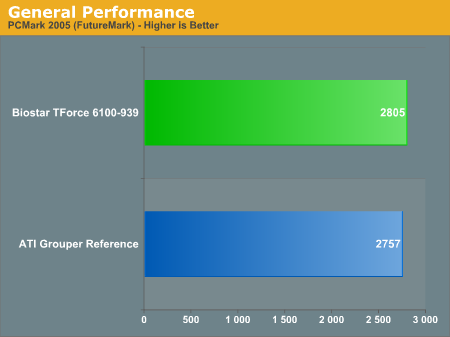
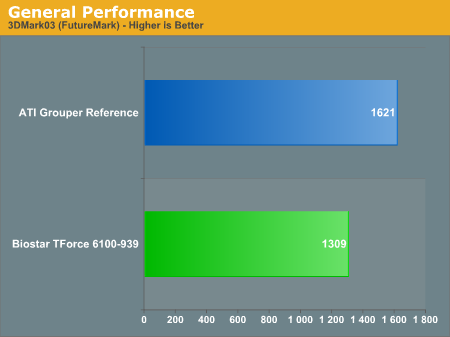
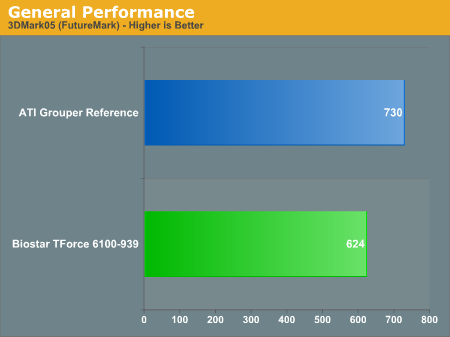
No one would ever try to say that 1621 is a great 3DMark03 score or that a 730 3Dmark05 is great performance. However, the ATI and NVIDIA integrated graphics did finish both benchmarks - something that many value solutions fail to do - and the ATI was the better performer in 3D Graphics.
Gaming Performance
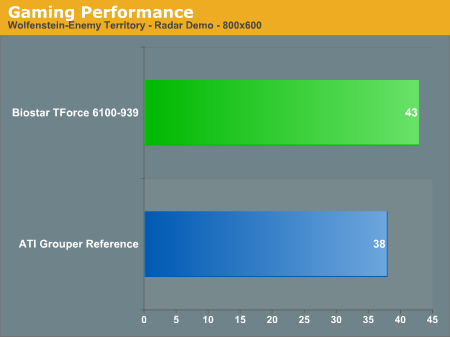
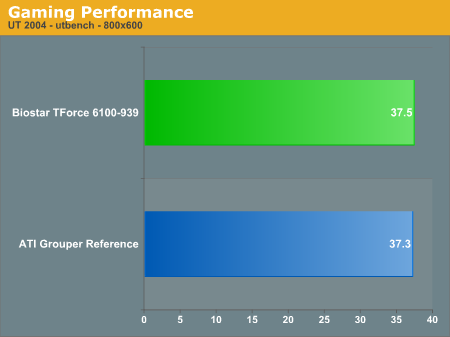

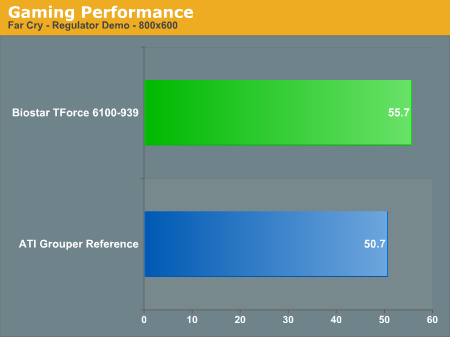
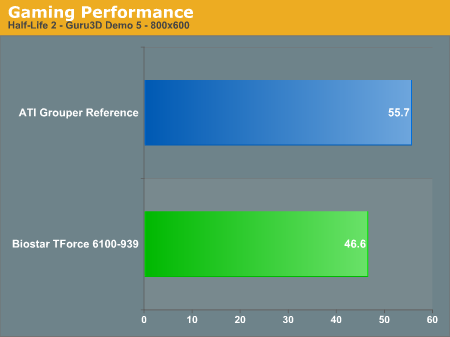
Our Take
Re-benching the ATI RS482 did not suddenly move the ATI chipset to the front in performance, but it does demonstrate that the ATI RS482 and the NVIDIA GeForce 6100 perform about the same in most benchmarks. The performance is certainly close enough that OEM's will have no overriding reason to choose one or the other chipsets based on a performance advantage. The good news is that buyers can choose either solution based on price or features and get pretty comparable results. NVIDIA has closed the integrated graphics performance gap, but they haven't surged ahead as many expected.
Either the ATI Radeon Xpress 200, with the new RS482 core, or the NVIDIA GeForce 6100 will provide business users, internet browsers, and casual computer users with competent graphics. Both chipsets do a decent job in most of the things for which we use our computers. Where both chipsets fail is with recent gaming. They can provide playable frame rates on all but the most demanding games at low resolutions with "eye-candy" turned off, but they will disappoint any serious gamer.
Sometimes we as reviewers make too much of that fact. Not everyone's dream is to run Fear on an Apple 30" Cinema with two 7800GTX or a Crossfire X1800 setup. Most users will find the graphics capabilities on both these chipsets pretty decent compared to the other choices in today's integrated graphics market. That is not to say that AnandTech readers will be happy, because they won't. But parents, grandparents, children, and siblings will find these integrated graphics just fine for web-browsing and e-mail. If they start buying more recent games, however, they will likely need a new graphics card.
It should also be pointed out that NVIDIA is just introducing AMD integrated graphics for the Athlon 64, while ATI has had competent integrated graphics solutions for both AMD Athlon 64 and Intel Socket 775 platforms for over a year. The great majority of integrated graphics boards are now based on the Intel platform, where NVIDIA does not yet offer an integrated graphics solution. That fact alone will keep ATI as a bigger player in the integrated graphics market.
While we are happy with the higher performance of both NVIDIA and ATI, this is not to say that integrated graphics have arrived. Who would really want to play Doom 3 at 24FPS at 800x600 - and that's with no eye candy? However, by lowering detail and resolution, you should be able to find a playable 640x480 or 800x600 with either the ATI or NVIDIA chipsets in most games. Nonetheless, if you want better detail or higher resolution, you will need to use a discrete video card with better performance.







